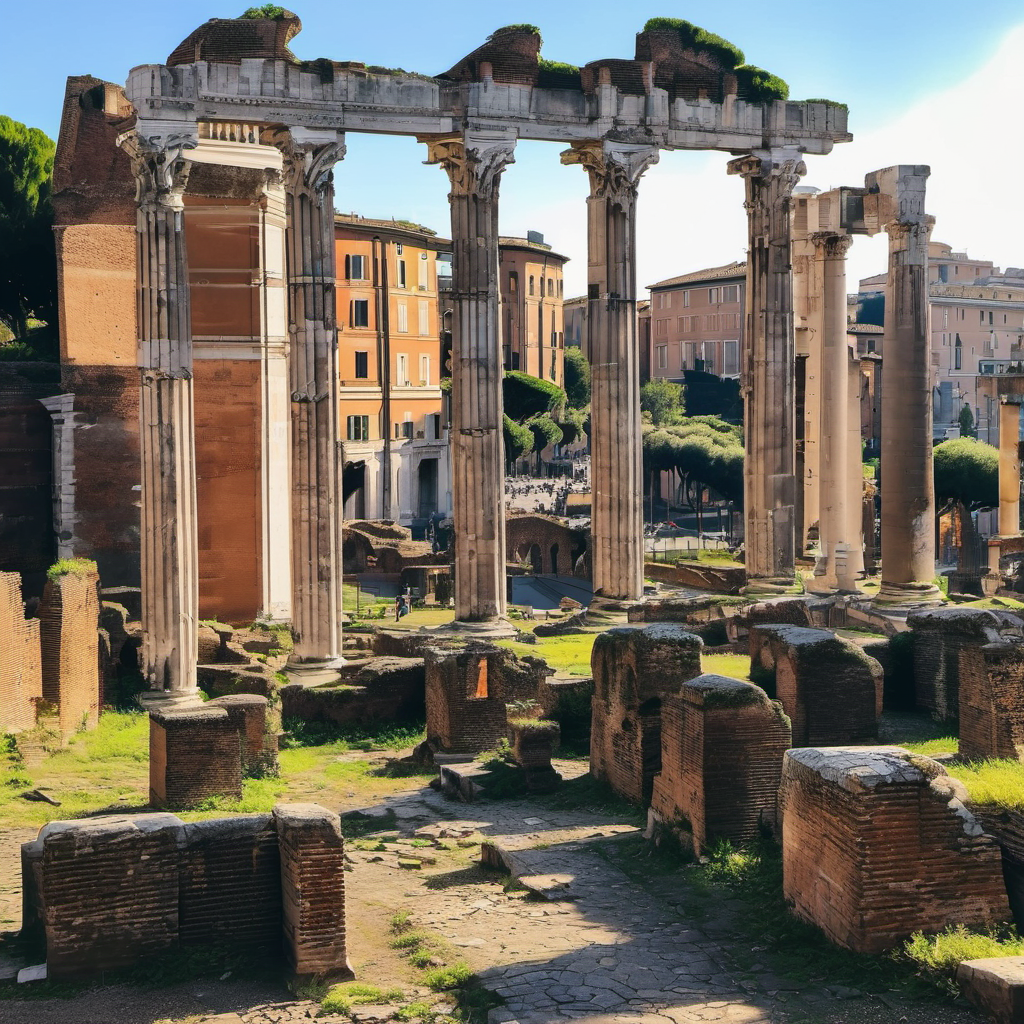
Exploring Ancient Ruins in Rome: An Adventurous 2024 Guide to the Eternal City:
Embarking on an exploration of Rome’s ancient ruins is akin to flipping through the pages of a vivid historical novel, each chapter brimming with tales of triumph, tragedy, and timeless grandeur. The Eternal City, as Rome is fondly called, hosts an array of ruins that are not merely relics but pulsating with life, echoing the glories of the Roman Empire. As we delve deeper into these storied locales, you’ll discover why Rome remains a top destination for adventurers and history enthusiasts in 2024.
The Iconic Colosseum:
Our first stop is the colossal Flavian Amphitheatre, better known as the Colosseum. Built in 70-80 AD, it remains a symbol of Rome’s architectural and engineering prowess. As you step inside, imagine the roar of up to 50,000 spectators, the gladiators preparing for battle, and the drama that unfolded in this monumental arena. In 2024, visitors can enjoy augmented reality tours that vividly recreate the ancient games, complete with virtual lions and gladiators, providing a deeply immersive experience that bridges the past with the present.
The Roman Forum: The Heartbeat of Ancient Rome:
A short walk from the Colosseum brings us to the Roman Forum, the nucleus of ancient Rome’s day-to-day life. This sprawling complex was the hub of Roman public life, hosting triumphal processions, elections, and public speeches. Today, the ruins stand as silent witnesses to the empire’s history, with still-standing columns and remnants of ancient temples. Explore the Senate House, or Curia, where decisions that shaped the world were made. With every step on its Via Sacra, you’re literally walking the same path that Julius Caesar and other notable historical figures once did.
Palatine Hill: Where Rome Was Born:
Overlooking the Forum is Palatine Hill, one of Rome’s seven hills and considered the birthplace of the city. Legend says that it was here that Romulus founded Rome, and it became the home of emperors and aristocrats. Exploring Palatine Hill offers a more serene experience, away from the crowds of the Forum and Colosseum. The hill provides not just remarkable ruins but also breathtaking views over the Forum and across to the Circus Maximus, an ancient chariot racing stadium. The hill is also home to the House of Augustus and the House of Livia, which boast exquisite frescoes that have been marvelously preserved.
Baths of Caracalla: A Glimpse into Roman Leisure:
To understand the leisurely pursuits of the ancient Romans, a visit to the Baths of Caracalla is essential. These were more than just public baths; they were a social and cultural hub where Romans of all classes mingled. The complex included gyms, libraries, and gardens. The ruins here are vast and evocative, giving visitors a real sense of the scale and the luxury that characterized these baths. In 2024, innovative light shows illuminate the baths at night, offering a spectacular visual journey through Roman social life.
Ostia Antica: A Journey to Rome’s Ancient Port:
A bit outside the main city, Ostia Antica offers a unique peek into the lives of everyday Romans. This ancient port city was crucial for the trade that flowed into Rome. The excellently preserved streets, mosaics, and houses offer a more complete picture of ancient Roman life away from the capital’s grand monuments. The site is less crowded, allowing for a more thoughtful exploration of its bakeries, baths, and temples, untouched by the passage of millennia.
Making the Most of Your Visit in 2024:
When planning your visit to Rome’s ruins in 2024, consider these tips to enhance your experience:
- Timing is Key: Visit early in the morning or later in the afternoon to avoid the crowds and the midday heat.
- Guided Tours: Opt for guided tours, especially those that offer access to areas normally closed to the public. These guides provide invaluable insights and historical context that enrich your experience.
- Wear Comfortable Shoes: You’ll be walking on uneven surfaces, so sturdy footwear is a must.
- Stay Hydrated: Carry a water bottle, which you can refill at the city’s numerous drinking fountains.
Rome’s ancient ruins are not just remnants of the past; they are timeless landmarks that offer endless discovery. With new technologies making these historical experiences more immersive, your 2024 adventure in the Eternal City promises to be as enriching as it is exciting. Whether you are a history enthusiast or an adventure seeker, Rome beckons with open arms and ancient tales waiting to be retold.
Adventure Awaits: Exploring Ancient Ruins:
Exploring the ancient ruins of Rome offers more than a walk through history; it’s an adventure that stirs the soul and ignites the imagination. For those who are drawn to the mystery and grandeur of bygone eras, Rome presents a labyrinth of legendary sites, each with a story to tell and a secret to share. Let’s delve into what makes each of these iconic ruins a cornerstone of adventure in the Eternal City.
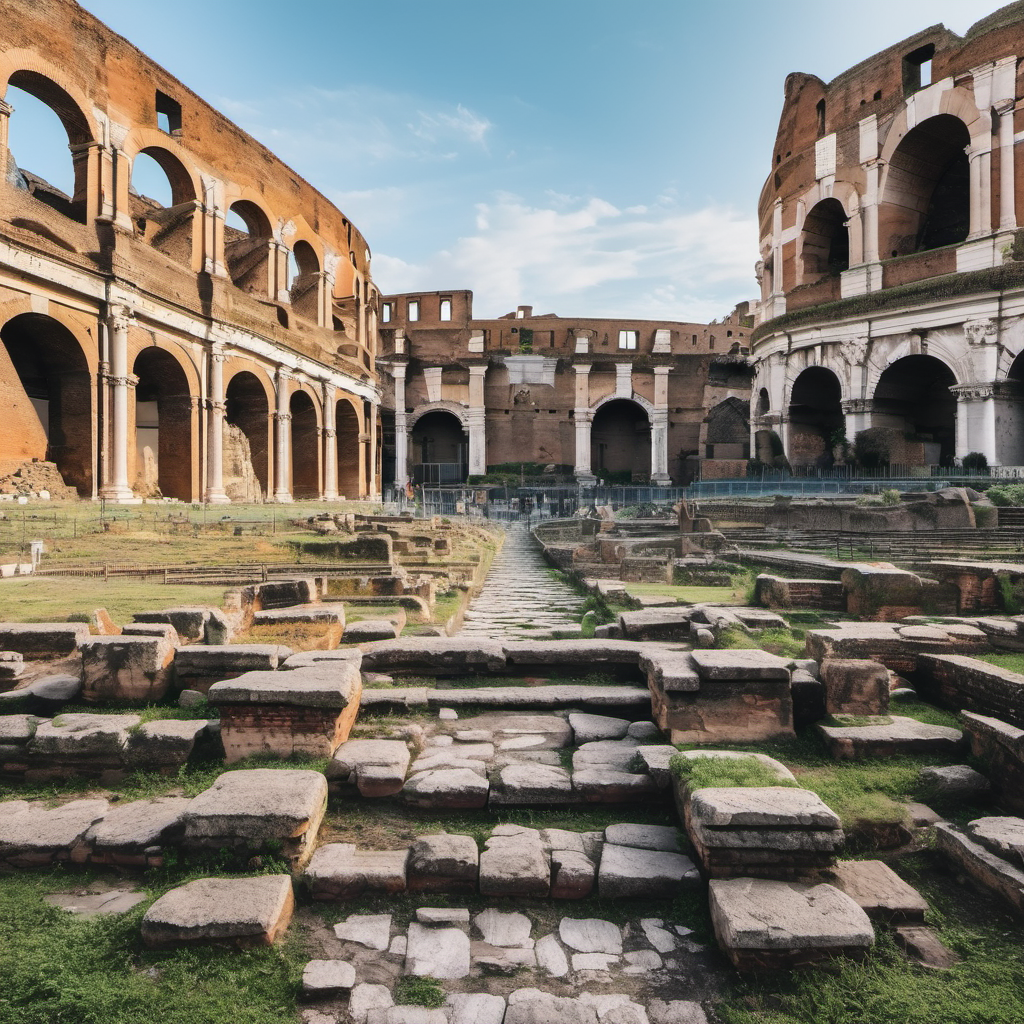
The Colosseum: Echoes of Ancient Spectacles:
The grandeur of the Colosseum not only epitomizes Roman architectural genius but also its cultural might. As adventurers step inside, they are transported to an era where the ground trembled with the cheers of thousands and the fate of gladiators was decided by the crowd’s roar. The Colosseum’s ongoing restoration efforts, especially in 2024, have opened more of its underground chambers to the public—areas where gladiators once prepared for combat and exotic animals were caged before being hoisted into the arena. These newly accessible sections offer a visceral glimpse into the complex workings of the ancient entertainment industry, making the exploration feel like uncovering a buried, bustling world.
The Roman Forum: A Tapestry of Time:
Walking through the Roman Forum is akin to navigating a 3D tapestry of Roman history. Each path and building tells a unique story, from the regal Arch of Titus commemorating victory in Judea to the Temple of Saturn, once home to the state treasury. The adventure here is intellectual and physical as visitors climb the Palatine Hill for panoramic views or descend into ancient political centers. The Forum, more than any other site, reflects the layers of Rome’s history, with ruins from different eras standing side by side. Each visit can feel like a new discovery, as subtle details and lesser-known corners emerge, revealing the daily life and grand events of the Empire.
Via Appia Antica: The Road to the Past:
For a truly immersive adventure, step onto the Via Appia Antica, one of Rome’s oldest roads. This ancient highway, lined with crumbling tombs and milestones, once connected Rome with distant parts of the empire. Today, it offers a serene escape from the bustling city center, where you can walk, bike, or even ride horses along the same stones that Roman soldiers and merchants traveled thousands of years ago. The road and its surroundings are dotted with ruins, catacombs, and ancient sculptures, offering endless opportunities for exploration and reflection on the reach and connectivity of the ancient Roman world.
Baths of Diocletian: Marvels of Ancient Engineering:
Exploring the Baths of Diocletian reveals the Roman mastery of engineering and their understanding of leisure. These baths were not just about cleanliness but were a multifaceted leisure complex complete with libraries, gardens, and exercise yards. Walking through these ruins, adventurers can marvel at the advanced heating systems and the grand scale of the architecture. The baths’ sheer size and the sophistication of their amenities speak volumes about the daily life and priorities of ancient Romans, providing a fascinating glimpse into their societal structure and personal indulgences.
Capitoline Hill: Where Legends Meet Reality:
Finally, no adventure through Rome’s ancient ruins is complete without a visit to the Capitoline Hill. Once the citadel of the earliest Romans, it is now home to the Capitoline Museums, where artifacts from the city’s ruins are preserved and displayed. The hill itself offers a journey through myths and legends, crowned by the magnificent view of the Roman Forum below. Exploring this area allows adventurers to stand where soothsayers once interpreted omens and where triumphant generals celebrated their victories, thus connecting the physical height with the lofty heights of Roman mythology and history.
Maximizing Your Adventure:
To truly savor these ancient ruins, adventurers should consider these tips:
- Engage with Interactive and Augmented Reality Tours: Many sites now offer AR experiences that reconstruct the past, providing context and bringing ruins to life.
- Participate in Night Tours: Experience the dramatic side of these ancient sites under the stars, where special lighting and fewer crowds create a mysterious atmosphere.
- Join Scholar-Led Tours: For those deeply interested in history, tours led by archaeologists or historians can provide deeper insights and anecdotes not commonly known.
Each ruin in Rome offers a door to the past waiting to be opened, promising adventures that are as educational as they are exhilarating. Whether you’re a history buff, a lover of architecture, or simply in awe of ancient civilizations, Rome’s storied ruins provide a uniquely rich tapestry to explore.
Culinary Delights: Top 10 Restaurants in Rome:
Rome’s culinary scene is a delightful exploration of flavors that range from traditional Roman recipes passed down through generations to innovative dishes that reimagine Italian cuisine. Dining in Rome is as much about the experience as it is about the food, combining the rich history of the city with its vibrant contemporary culture. Here are the top 10 restaurants in Rome that are must-visits for any food lover visiting the city in 2024.
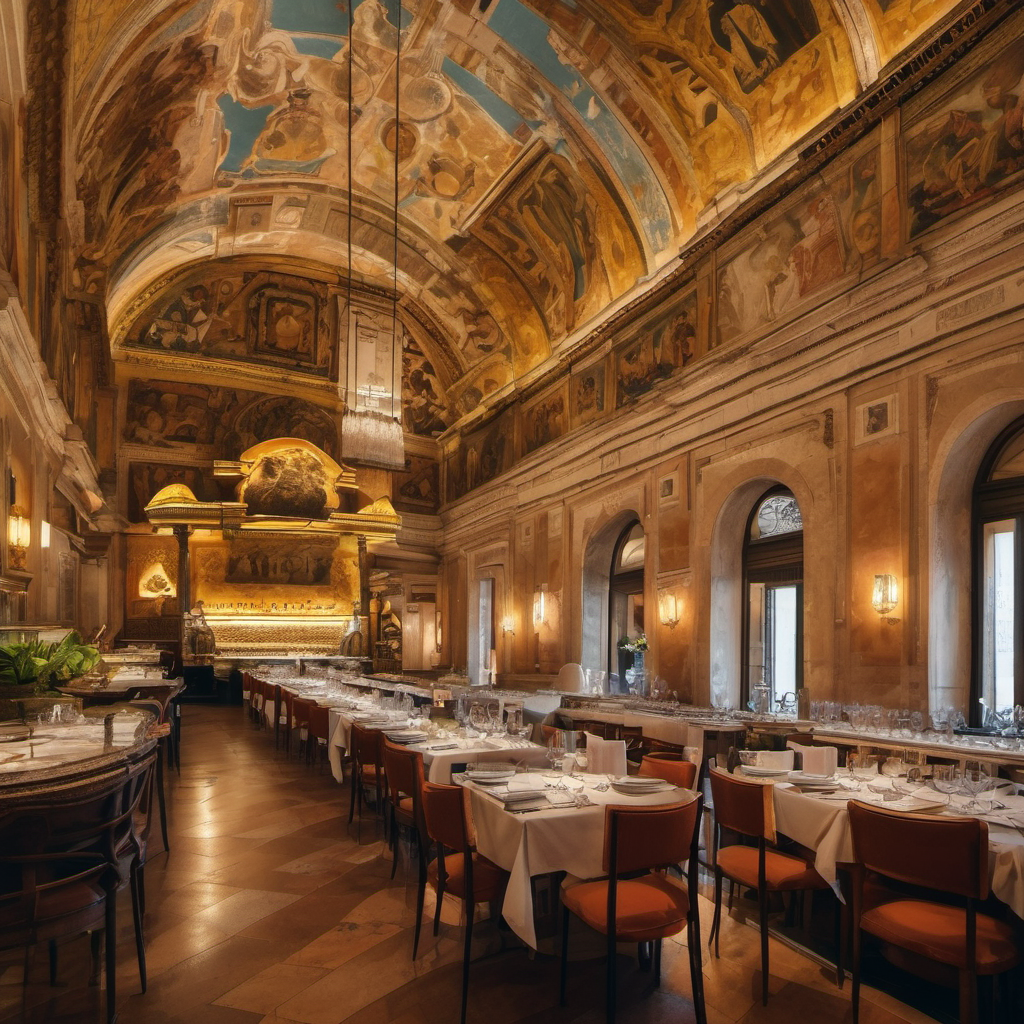
1. La Pergola:
Perched atop the Rome Cavalieri Hotel, La Pergola is not only Rome’s most prestigious restaurant but also the only one with three Michelin stars. Under the direction of Chef Heinz Beck, La Pergola offers exquisite dishes crafted from the finest ingredients and an impressive wine list in a setting that boasts panoramic views of the Eternal City. The tasting menu, which might include specialties like Wagyu beef or black truffle risotto, is an experience in itself.
2. Roscioli:
A combination of restaurant, deli, and bakery near Campo de’ Fiori, Roscioli offers a unique dining experience with its vast selection of artisanal cheeses, cured meats, and traditional pastas. Try their signature carbonara, made with crisp guanciale and Pecorino Romano, which many claim is the best in Rome.
3. Pipero Roma:
Known for its elegance and hospitality, Pipero Roma is the place to go for a refined take on Roman classics. The star of the menu is the carbonara, prepared tableside, creating a show that’s as much a part of the meal as the eating itself. The attentive service and curated wine list complement the food perfectly.
4. SantoPalato:
SantoPalato, located in the San Giovanni neighborhood, brings the traditions of Roman trattorias into the modern age. Chef Sarah Cicolini serves up Roman classics like trippa alla romana (tripe cooked in tomato sauce) and pajata (intestines of an unweaned calf), which are both much better than they might sound to the uninitiated.
5. Antico Arco:
On Gianicolo Hill, Antico Arco presents a sophisticated menu that takes full advantage of local and seasonal ingredients, crafting dishes that are inventive yet respectful of traditional Italian techniques. Their degustation menu is a favorite, featuring dishes that are both visually stunning and delicious.
6. Armando al Pantheon:
Steps away from the ancient Pantheon, this historic spot offers a deeply traditional Roman dining experience. Armando al Pantheon has been serving classics like saltimbocca and amatriciana since 1961. It’s a small, family-run place, so booking ahead is essential.
7. Da Enzo:
In the Trastevere district, Da Enzo is a tiny trattoria that embodies the soul of Roman cuisine. It’s known for its authentic dishes like cacio e pepe and carciofi alla giudia (Jewish-style artichokes). Its intimate size and popularity mean you might have to wait for a table, but the food is well worth it.
8. Per Me Giulio Terrinoni:
Located in the charming Vicolo del Malpasso near the Tiber River, this Michelin-starred restaurant offers a seafood-focused menu crafted by Chef Giulio Terrinoni. The dishes are creative and beautifully presented, highlighting the freshness of the ingredients.
9. Le Mani in Pasta:
A casual yet upscale trattoria in Trastevere, Le Mani in Pasta is a favorite among locals and tourists alike. Specializing in seafood pasta, this spot offers robust flavors and fresh ingredients. The gricia with zucchini flowers is a must-try.
10. Pizzeria Ai Marmi:
For a more casual meal, Pizzeria Ai Marmi in Trastevere offers what many consider the quintessential Roman pizza experience. Known locally as ‘l’obitorio’ (the morgue) because of its long, marble-topped tables, the pizzeria serves thin-crust pizzas that are perfect in their simplicity.
Tips for Dining out in Rome:
- Reservations are Recommended: Many of these popular spots are small and fill up quickly, especially in the tourist season.
- Dress Code: While most restaurants in Rome are casual, fine dining establishments like La Pergola require a more formal attire.
- Enjoy the Pace: Dining in Rome is not rushed. Embrace the leisurely pace and enjoy each course.
- Local Wine: When dining out, ask for local wines. Lazio, the region around Rome, produces some excellent varieties that are often well-priced.
Each restaurant on this list offers a unique perspective on Roman cuisine, providing not just a meal but an experience that is deeply embedded in the cultural fabric of the city. Whether you’re looking for a classic dish or an inventive modern meal, Rome’s top restaurants promise to satisfy your culinary cravings with flair and flavor.
A Feast for the Senses: Top 15 Things to Do in Rome:
Rome, a city of immense cultural and historical depth, offers a kaleidoscope of experiences that cater to all senses. Whether you are drawn to the visual grandeur of ancient art, the resonant echoes of historic streets, or the vibrant tastes and aromas of Italian cuisine, Rome promises an unforgettable journey. Here’s a comprehensive list of the top 15 things to do in Rome that will leave you enriched, educated, and exhilarated.
1. Vatican Museums and Sistine Chapel:
Begin your Roman adventure with a visit to the Vatican Museums, where art and history converge spectacularly. Home to a vast collection of priceless artworks from various eras, including the Renaissance masterpieces, the highlight is undoubtedly Michelangelo’s ceiling in the Sistine Chapel. The intricate details and profound artistry render many speechless.
2. St. Peter’s Basilica:
Adjacent to the Vatican Museums is St. Peter’s Basilica, a monumental work of Renaissance architecture. Climb to the dome for a breathtaking view of Vatican City and beyond. Inside, you can see Michelangelo’s Pietà and the opulent Baldachin by Bernini.
3. Colosseum:
No trip to Rome is complete without visiting the iconic Colosseum. Explore the ancient amphitheater that was once the stage for gladiator battles, mock sea battles, and various public spectacles. A guided tour can enhance your understanding of its history and architecture.
4. Roman Forum:
Step back in time with a stroll through the Roman Forum, the heart of Roman public life for centuries. The scattered fragments of temples, basilicas, and vibrant public spaces paint a vivid picture of ancient Roman life.
5. Palatine Hill:
Explore the site where Rome was founded and view the ruins of the imperial palaces. Palatine Hill offers a fantastic vista of the Forum and the modern city. It’s particularly magical at sunset.
6. Trevi Fountain:
The Baroque artistry of the Trevi Fountain is a spectacle of beauty and tradition. Legend has it that throwing a coin over your shoulder into the fountain ensures a return to Rome. The fountain’s majestic sculptures and cascading waters make for a stunning photo opportunity.
7. Pantheon:
Visit the Pantheon, a remarkable example of ancient Roman architecture. Originally a temple to all the gods, this building is now a church and a tomb for several important Italians, including the artist Raphael.
8. Spanish Steps:
Climb the Spanish Steps, a popular gathering place and a prime example of Roman Baroque style. The steps lead up to the beautiful Trinità dei Monti church, and the area is great for people-watching or enjoying a gelato.
9. Piazza Navona:
Roam around Piazza Navona, one of Rome’s liveliest squares, known for its stunning Baroque architecture. It features three impressive fountains, including Bernini’s Fountain of the Four Rivers, and is surrounded by restaurants and street artists.
10. Galleria Borghese
The Borghese Gallery houses a substantial collection of art, sculpture, and antiquities, set within the verdant Borghese Gardens. Highlights include works by Caravaggio, Bernini, and Titian.
11. Campo de’ Fiori Market:
Experience the bustling Campo de’ Fiori Market, a daily flower and food market that transforms into a lively nightlife area in the evenings. It’s a great spot to sample fresh local foods and observe local life.
12. Testaccio Market:
For a deeper dive into Roman culture, visit Testaccio Market, where you can indulge in authentic Roman street food and shop for local ingredients. It’s less touristy and full of local flavor.
13. Ostia Antica:
Take a half-day trip to Ostia Antica, an ancient port city remarkably preserved. The ruins here give Pompeii a run for its money, offering a glimpse into everyday life in ancient Rome without the crowds.
14. Via Appia Antica:
Rent a bike and ride along the Appian Way, one of Rome’s ancient roads, lined with catacombs and ruins. It’s a peaceful retreat from the city’s hustle.
15. Night Tour of Rome:
Finally, see a different side of Rome with a night tour, which highlights the city’s monuments illuminated against the night sky. It’s a dramatic and less crowded way to appreciate Rome’s eternal beauty.
Tips for Enjoying Rome:
- Book Tickets in Advance: Many of these attractions are incredibly popular. Booking tickets online in advance can save you hours of waiting in line.
- Wear Comfortable Shoes: Rome’s cobblestone streets are charming but can be hard on your feet.
- Stay Hydrated: Keep a water bottle handy, as exploring Rome can be thirsty work, especially in the warmer months.
Each of these experiences offers a unique perspective on Rome’s rich tapestry of history, culture, and art, making your visit a truly comprehensive immersion into the heart of Italy. Whether you’re marveling at ancient ruins, enjoying a sunset, or savoring culinary delights, Rome promises an enchanting adventure that engages all the senses.
Wildlife and Nature: Rome’s Green Side:
While Rome’s architectural and historical marvels capture much of the attention, the city’s green spaces and wildlife offer tranquil and picturesque escapes, showcasing a different side of the Eternal City. Rome’s parks, gardens, and protected areas not only provide a respite from the urban hustle but also a chance to engage with Italy’s diverse flora and fauna. Here are some key places and experiences that highlight Rome’s commitment to preserving its natural beauty.

1. Bioparco di Roma:
Nestled in the historical setting of Villa Borghese, the Bioparco di Roma is one of the oldest zoological gardens in Europe. Home to over 1,000 animals representing about 200 species, the zoo focuses on conservation and education about biodiversity. The park is beautifully landscaped to mimic the natural habitats of the species it houses, from exotic birds to majestic mammals like lions and tigers. It’s particularly appealing for families, offering a variety of educational programs and interactive encounters with animals.
2. Villa Borghese Gardens:
Adjacent to the Bioparco, the expansive Villa Borghese Gardens offer one of the largest public parks in Rome. This English-style garden features walking paths, statues, fountains, and several museums. You can rent a bike or a rowboat to explore its picturesque landscape, which includes a beautiful lake. It’s a favorite spot for both tourists and locals to unwind, picnic, and enjoy outdoor performances.
3. Villa Doria Pamphili:
As the largest landscaped public park in Rome, Villa Doria Pamphili is a spectacular example of a Roman country estate, complete with a baroque villa. The park’s meadows, pine woods, and ornamental lakes make it an ideal location for jogging, cycling, or simply strolling along the many paths. It’s also a great spot for bird-watching, as the park is home to a variety of bird species that thrive in its mixed habitats.
4. The Appian Way Regional Park (Parco Regionale dell'Appia Antica):
For those interested in combining historical exploration with nature, the Appian Way Regional Park offers an excellent opportunity. This protected area preserves part of the ancient Roman road, the Appian Way, and its surrounding landscapes. The park is rich in archaeological sites and is lined with catacombs, ancient ruins, and old Roman villas. The greenery along the road is lush, and the park is home to many species of wildflowers, birds, and small mammals.
5. Orto Botanico (Botanical Garden):
Located in the Trastevere district, the Orto Botanico is part of the University of Rome. This botanical garden boasts over 3,000 species of plants and is an oasis of tranquility away from the bustling city streets. The gardens are divided into several sections, including a Japanese garden, a Mediterranean garden, and a bamboo grove, making it a fascinating place for botanical enthusiasts and casual visitors alike.
6. The Gardens of Ninfa:
A bit outside Rome, the Gardens of Ninfa are a must-visit for nature lovers. This landscaped garden is built on the ruins of the medieval town of Ninfa, creating a stunning blend of history and natural beauty. The gardens are known for their lush plant life and vibrant flowers as well as their streams and ponds, which create a magical atmosphere. The site is carefully maintained to preserve its ecological balance, hosting a variety of birds and aquatic life.
Experiencing Nature in Rome:
To fully enjoy Rome’s green side, consider these tips:
- Respect the Environment: Always follow guidelines and respect the natural habitats you visit to ensure these spaces remain pristine for future generations.
- Plan Seasonally: Some gardens and parks are particularly stunning in specific seasons. For example, the rose garden in the Orto Botanico is a highlight in the spring.
- Pack Appropriately: For day trips to parks and gardens, bring essentials like water, sun protection, and comfortable walking shoes.
These natural havens provide a perfect counterbalance to the urban and historical exploration of Rome, offering peaceful retreats and a chance to appreciate Italy’s rich ecological diversity. Whether you’re an avid birdwatcher, a botanical enthusiast, or simply seeking a quiet place to relax, Rome’s green spaces are as integral to the city’s charm as its ancient ruins and bustling piazzas.
Family Fun: Activities for All Ages in Rome:
Rome, with its storied past and vibrant culture, offers a plethora of activities that cater to families and visitors of all ages. From historical adventures that spark the imagination to interactive museums and outdoor escapades, the city is brimming with opportunities to engage and entertain both children and adults alike. Here’s a guide to some of the best family-friendly activities in Rome that ensure a memorable experience for everyone.
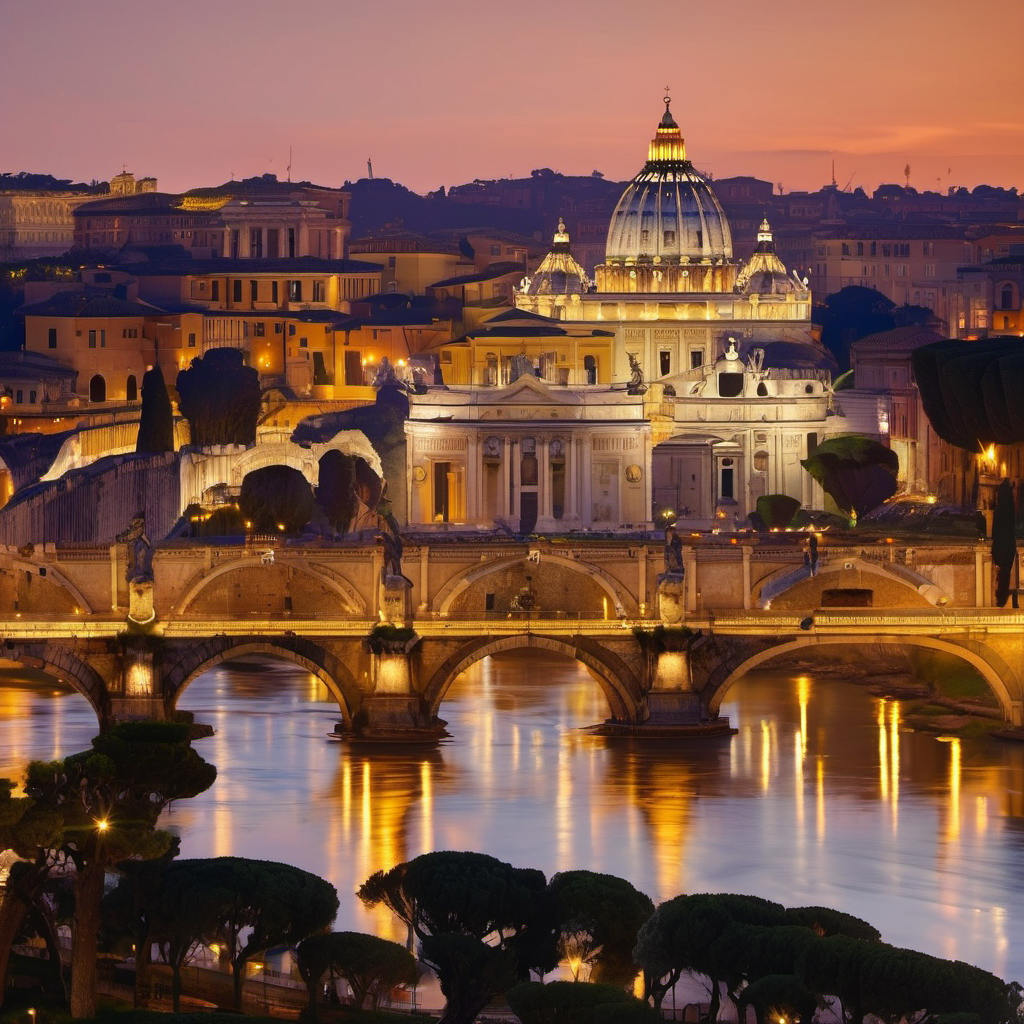
1. Explora: The Children’s Museum of Rome:
This museum is specifically designed for children, offering interactive exhibits that encourage learning through play. The museum features a variety of hands-on activities that cover themes like science, technology, and culture. Children can learn how a city works in the mini-city exhibit, where they can pretend to be adults performing jobs like running a bank, piloting an airplane, or working in a supermarket.
2. Time Elevator Rome:
Time Elevator Rome is a 5D cinema experience that takes you on a journey through the history of Rome. With moving platforms and special effects, including wind and mist, this experience makes history come alive in an exciting and accessible way for kids. The show covers 3,000 years of Roman history, from Romulus and Remus to the modern day, making it an educational and thrilling ride.
3. Vatican Museums: Family Tours:
The Vatican offers special family tours that are tailored to engage younger visitors, making the vast collections more accessible and intriguing for children. These tours often include interactive elements and storytelling to capture the imagination of young ones while ensuring that adults also find the experience enriching.
4. BioParco di Roma:
Rome’s zoo focuses on conservation and education, making it a perfect spot for a family day out. The zoo is home to over 1,000 animals and offers a variety of educational programs designed to teach children and adults about biodiversity and the importance of conservation. The park-like setting and picnic areas provide a great space for relaxation after meeting the animals.
5. Hydromania Water Park:
For a break from the city’s historical sites, take the family to Hydromania, Rome’s largest water park. With slides, pools, and play areas for all ages, it’s a refreshing escape on a hot summer day. The park offers something for everyone, from adrenaline-pumping rides for teens to toddler-friendly splash areas.
6. Ostia Beach:
Just a short train ride from Rome, Ostia Beach provides a sandy escape from the city hustle. Families can enjoy a day of sun, sea, and relaxation. The beach is well-equipped with amenities, including public showers, sunbeds for rent, and plenty of cafes and restaurants.
7. Technotown:
Located in Villa Torlonia, Technotown is an interactive technology center where children can engage in educational workshops and activities focused on science and technology. The exhibits are designed to inspire creativity and innovation, with activities like robotics workshops, virtual reality experiences, and multimedia adventures through the villa’s history.
8. Villa Borghese Gardens:
Rent a bike or a pedal-powered cart to explore these expansive gardens. Villa Borghese is not only a beautiful park but also home to playgrounds, a lake where you can rent rowboats, and several museums. The Cinema dei Piccoli, the smallest cinema in the world, often shows children’s films.
9. Gladiator School:
Give your children a truly unique experience by enrolling them in Gladiator School for a day. They will learn about ancient Roman history through the perspective of a gladiator, including lessons in traditional fighting techniques and the chance to wear authentic-looking armor. This hands-on approach is not only educational but also a lot of fun.
10. Catacombs Tour:
For older children and teens, exploring Rome’s ancient catacombs can be an intriguing adventure. Tours of these underground burial sites like the Catacombs of San Callisto offer a glimpse into the early Christian and Roman customs and are both eerie and fascinating.
Tips for Family Trips to Rome:
- Start Early: Many of Rome’s attractions fill up quickly. Arriving early can help you avoid the crowds and the heat, especially during the summer.
- Stay Flexible: Rome can be overwhelming with children, so it’s important to maintain a flexible schedule that allows for rest and unplanned explorations.
- Snack Wisely: Keep snacks handy for quick energy boosts, and try to include meals at child-friendly restaurants that offer a more relaxed dining experience.
Rome offers an array of activities that can educate and fascinate children while providing entertainment and relaxation for adults. With a little planning, a family vacation in Rome can be an enriching experience for visitors of all ages, filled with learning, adventure, and unforgettable memories.
Romantic Rome: Nightlife and Nightclubs:
Rome, with its timeless beauty and vibrant culture, offers a rich tapestry of nighttime activities perfect for couples looking for romance or an unforgettable night out. The Eternal City lights up after dark with an array of options from cozy wine bars to high-energy nightclubs, each providing a unique way to experience the city’s lively and romantic atmosphere. Here’s a closer look at Rome’s nightlife and the best places for couples to enjoy an evening together.

1. Vinoteca Novecento:
Begin a romantic evening with a visit to Vinoteca Novecento, a charming wine bar located near the historic center. This intimate spot offers an extensive selection of Italian and international wines. The knowledgeable staff can help you choose the perfect wine to complement a selection of cheeses and cured meats, setting the tone for a sophisticated night out.
2. Salotto 42:
For a trendy and stylish experience, head to Salotto 42, a boutique bar situated opposite the ancient Temple of Hadrian. Known for its chic decor and cosmopolitan vibe, this place is popular with both locals and tourists. Enjoy their creative cocktails and the selection of small plates while soaking in the ambiance enhanced by good music and elegant surroundings.
3. The Jerry Thomas Project:
Dive into the world of speakeasies at The Jerry Thomas Project, Rome’s answer to the prohibition-era secret bar. Entry requires a password (available by visiting their website), making the experience all the more exclusive and intriguing. Inside, you’ll find a dimly lit, romantic setting where expert mixologists serve up bespoke cocktails, each crafted with unique spirits and flavors.
4. Micca Club
Micca Club blends the allure of a retro nightclub with the vibrancy of modern dance music, making it a perfect spot for couples who love to dance. The club often features live music, ranging from jazz to swing, and later in the evening transitions into more contemporary beats. Its vintage decor and intimate seating areas provide a glamorous backdrop for a night of dancing and enjoyment.
5. Freni e Frizioni:
Freni e Frizioni is a lively bar in the Trastevere area, known for its vibrant atmosphere and excellent cocktails. It’s a great spot to mingle with the locals and other visitors in a casual setting. The outdoor terrace offers a fantastic view of the bustling streets, ideal for a romantic evening spent enjoying the Roman night air.
6. Club der Visionaere:
For something a bit different, Club der Visionaere offers a unique experience with its focus on electronic music and a laid-back, almost bohemian atmosphere. Located along the Tiber River, this club is perfect for couples looking to enjoy a less conventional nightclub scene. The music, the riverside setting, and the relaxed vibe make it a popular choice among the younger crowd.
7. Alcazar Live:
Alcazar Live, located in the Trastevere district, is a live music venue and cinema that transforms into a dance club on select nights. It’s ideal for couples who appreciate live performances in genres ranging from rock to electronic. The venue’s eclectic programming ensures that there’s something to match nearly every musical taste.
8. La Cabala:
Located in a medieval palace near the Tiber River, La Cabala is a nightclub set in the attic of a 15th-century building. This exclusive club offers a mix of house music and hits, attracting a chic crowd. The sophisticated setting and the stunning views of the historic center create a magical backdrop for a night out.
9. Gregory’s Jazz Club:
For jazz lovers, Gregory’s Jazz Club is a must-visit. This intimate venue offers live jazz music in a cozy setting, perfect for couples looking to enjoy a more laid-back and sophisticated evening. The club’s warm atmosphere and top-notch performances make it a beloved spot among music aficionados.
Tips for Enjoying Rome’s Nightlife:
- Dress Code: Many of Rome’s nightclubs have a dress code, especially the more upscale venues. It’s a good idea to check ahead and dress accordingly.
- Reservations: For popular spots, especially wine bars and clubs like The Jerry Thomas Project, reservations are highly recommended.
- Late Start: Remember that nightlife in Rome starts late, with many not heading out until after 10 PM, and clubs getting busier well after midnight.
Rome’s nightlife offers romantic settings, cultural experiences, and lively entertainment, making it an essential aspect of the city’s charm for couples. Whether you’re sipping wine under the stars or dancing until dawn, Rome provides a perfect backdrop for romantic adventures and memorable nights out.
A Stroll Through History: Exploring Rome’s Rich Past and Present:
Rome, often referred to as the “Eternal City,” offers a unique blend of rich historical layers that span thousands of years, intertwined with the vibrancy of modern urban life. This fusion makes Rome a living museum, where every street, building, and corner tells a story. For those looking to delve into the city’s past while experiencing its contemporary culture, a stroll through Rome offers a deep dive into its history and an appreciation of its present.
1. The Colosseum:
Begin your historical journey at the Colosseum, perhaps the most iconic symbol of Rome’s imperial might. This ancient amphitheater, which could hold up to 80,000 spectators, hosted gladiatorial contests, public spectacles, and theatrical performances. Walking through the same entrances that ancient Romans once used, you can almost hear the echoes of the crowds and feel the intensity of the historic battles that took place within these walls.
2. Roman Forum:
A short walk from the Colosseum brings you to the Roman Forum, the heartbeat of ancient Rome. This sprawling complex was the center of Roman public life, hosting triumphal processions, elections, and public speeches. Today, you can stroll among the ruins of ancient temples, basilicas, and vibrant public spaces, imagining the political and social dramas that unfolded here.
3. Pantheon:
As you wander through the city, make sure to visit the Pantheon, a masterpiece of Roman engineering and architecture. Originally built as a temple to all the gods, the Pantheon has stood for nearly two millennia, thanks to its revolutionary dome and oculus, which remain a source of architectural inspiration. The building now serves as a church and a tomb for Italian kings and notable figures like the artist Raphael.
4. Trevi Fountain:
Continue your exploration to the Trevi Fountain, one of the most beautiful Baroque fountains in the world. A tradition claims that if visitors throw a coin into the fountain, they are ensured a return to Rome. The fountain’s design, featuring the god Oceanus, reflects Rome’s historical reliance on water brought by its ancient aqueducts.
5. Spanish Steps:
The Spanish Steps, another quintessential Roman landmark, offer a perfect spot to observe the blend of Rome’s historical and modern lifestyles. These steps have been a meeting place for centuries, attracting artists, writers, and travelers. The vibrant atmosphere here is a testament to the city’s enduring appeal.
6. Trastevere:
To experience the day-to-day life of modern Romans while still being surrounded by history, head to the Trastevere neighborhood. This charming area, with its narrow cobbled streets lined with medieval houses, offers a glimpse into the Rome of yesteryears, juxtaposed with lively cafes, boutiques, and artisan shops that represent Rome’s contemporary cultural scene.
7. Vatican City:
No historical tour of Rome is complete without a visit to Vatican City. Home to the Pope and a trove of iconic art and architecture, it boasts St. Peter’s Basilica, the Sistine Chapel, and the Vatican Museums. The rich history of the Catholic Church intertwines deeply with the story of Rome itself, from ancient times to the present day.
8. Via Appia Antica:
For a deeper historical immersion, take a walk along the Via Appia Antica, one of the oldest and most important roads from Roman times. Lined with ancient tombs and ruins, this road offers a literal pathway through history and is an excellent example of Rome’s ability to preserve its past.
Tips for a Historical Stroll in Rome:
- Wear Comfortable Shoes: Rome’s attractions often involve a lot of walking, sometimes on uneven cobbles or pathways.
- Start Early: Many historical sites get crowded, especially in peak tourist seasons. Starting early will help you enjoy these places with fewer people.
- Hire a Guide or Use an Audio Guide: To fully appreciate the historical context of the sites you visit, consider hiring a local guide or using an audio guide.
By taking a stroll through Rome’s historical landmarks, you engage directly with the layers of history that have shaped this city over millennia. At the same time, Rome’s vibrant present-day culture offers a lively counterpoint, providing a full spectrum of experiences that highlight both the ancient and the contemporary aspects of the city.
Trending: Best Places to Visit in Rome in 2024:
Rome continues to evolve, offering visitors new and exciting experiences each year while maintaining its historical charm and cultural richness. As 2024 approaches, several places in Rome are trending as must-visit destinations, drawing both new visitors and those returning to the Eternal City. These spots range from recently restored historical sites to contemporary attractions that showcase modern Italian culture. Here’s a guide to the best places to visit in Rome in 2024, ensuring a well-rounded and memorable experience.
1. The Mausoleum of Augustus:
After extensive renovations, the Mausoleum of Augustus has reopened to the public, offering a unique glimpse into the life and times of Rome’s first emperor. This massive tomb is not only a site of significant historical importance but also a testament to Rome’s ongoing efforts to preserve its ancient artifacts. Visiting the Mausoleum is a chance to connect with the imperial history of Rome in a newly accessible way.
2. Cinecittà Studios
For a taste of the cinematic, Cinecittà Studios, the hub of Italian filmmaking, offers guided tours that explore the history of cinema and the making of some of Italy’s most famous films. In 2024, the studios continue to host exhibitions and events that celebrate both classic Italian cinema and contemporary productions, making it a trendy spot for film enthusiasts.
3. The MAXXI Museum:
The MAXXI Museum, dedicated to contemporary art and architecture, stands out for its innovative exhibitions and striking architecture designed by Zaha Hadid. In 2024, the museum is hosting several high-profile exhibitions that make it a must-visit for lovers of modern art and design.
4. Mercato Testaccio:
For a slice of local life mixed with delicious food, Mercato Testaccio is the place to be. This trendy market is where locals shop for fresh produce, but it’s also home to stalls offering some of Rome’s best street food. It’s a vibrant spot to enjoy authentic Roman dishes, from classic pastas to inventive new cuisine.
5. The Palatine Hill Light Show:
The Palatine Hill, already popular for its ancient ruins and spectacular views, is enhancing visitor experiences with a nighttime light show. These shows bring Rome’s ancient history to life through state-of-the-art technology that illuminates the ruins with stories from Rome’s past, making it a trending spot for both its educational and entertainment value.
6. Rome’s New Green Corridors:
As part of its initiative to become more sustainable, Rome is developing green corridors throughout the city. These new urban spaces are designed for pedestrians and cyclists, enriched with native plants and trees. They provide a refreshing, eco-friendly way to explore the city while escaping the usual tourist paths.
7. The Jewish Ghetto:
The historic Jewish Ghetto of Rome is gaining popularity for its rich history and vibrant cultural scene. The area’s restaurants, serving traditional Jewish-Roman cuisine, and the newly restored Museum of the Jewish Community make it a compelling destination for those interested in the diverse layers of Rome’s history.
8. Trastevere’s Artisan Workshops:
Trastevere is well-known for its bohemian atmosphere, but in 2024, it’s gaining an extra edge with the opening of several artisan workshops where visitors can observe traditional crafts in action. These workshops not only sell unique handmade goods but also offer workshops and classes, providing a hands-on way to experience Italian craftsmanship.
9. The Rome Science Festival:
Held annually, the Rome Science Festival has become increasingly popular, especially in 2024, with its focus on sustainable technologies and interactive science exhibitions. It’s a family-friendly event that showcases innovations and scientific discoveries through workshops, talks, and demonstrations.
Tips for Visiting Trending Places in Rome:
- Book in Advance: For trending spots, especially those with limited entry like the Mausoleum of Augustus or special exhibitions at MAXXI, booking tickets in advance is recommended.
- Check Local Events: Rome’s cultural calendar is packed, and checking for events or exhibitions can add value to your visit.
- Stay Connected: Follow local blogs or social media channels for updates on the latest openings and hidden gems around the city.
These trending places offer a fresh perspective on Rome, blending its illustrious past with dynamic contemporary developments. Whether you’re a history buff, a food lover, or a culture enthusiast, Rome in 2024 promises experiences that cater to all interests and help create lasting memories of your visit.
Navigating Rome: Transportation Tips:
Rome, a city where ancient history meets urban bustle, offers a range of transportation options suited for tourists and locals alike. Navigating the Eternal City can be part of the adventure, but it can also be daunting due to its complex layouts and busy traffic. To help you move around efficiently and enjoyably, here are some essential transportation tips for navigating Rome in 2024.
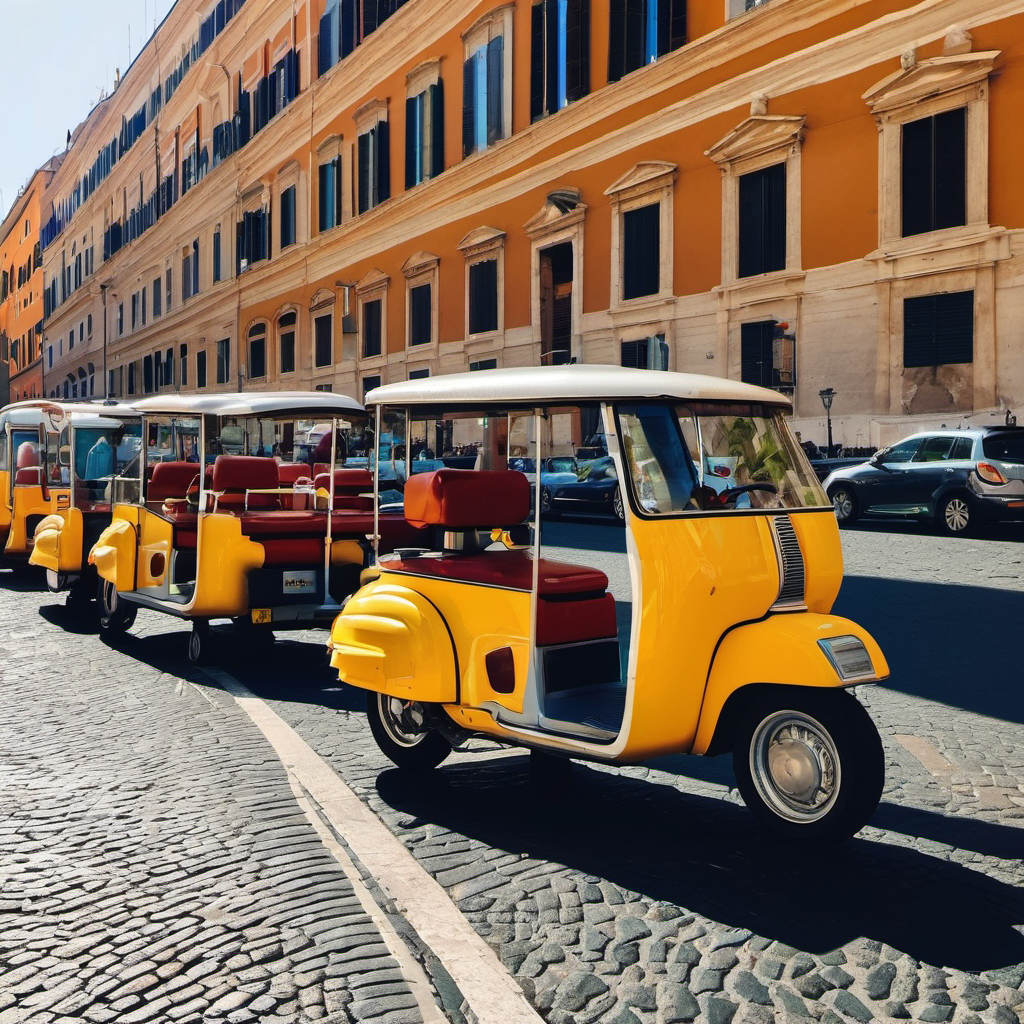
1. Utilize Public Transport:
Rome’s public transportation network includes buses, trams, metro lines, and suburban trains that cover most areas of the city and its outskirts. Here’s how to best use these options:
- Metro: Rome’s metro system is one of the easiest ways to get around, especially for visiting major attractions. The A (orange) and B (blue) lines intersect at Termini Station, the main transport hub. In 2024, look out for updates on the C line, which is still under expansion.
- Buses and Trams: With extensive routes that cover areas beyond the metro lines, buses and trams are invaluable. Buses can be slower due to traffic, but they reach many areas not accessible by metro. The tram network is less comprehensive but offers a scenic route around key districts.
- Suburban Trains: For day trips out of Rome, such as to Ostia Antica or Tivoli, suburban trains are efficient and cost-effective. The Roma-Lido line, for example, is perfect for a beach day at Ostia.
2. Tickets and Passes:
- ntegrated Tickets: A single ticket can be used on buses, trams, metro, and some trains within the city limits. Tickets are available at machines in metro stations, at tobacco shops, and at some newsstands.
- Tourist Passes: Consider purchasing a Roma Pass, which includes free use of public transportation, free or discounted entry to various museums and sites, and other benefits. This is especially valuable if you plan to visit multiple attractions.
- Apps and Technology: Utilize apps like ATAC, the official transport app, for real-time updates, routes, and schedules.
3. Opt for Walking:
Rome’s historical center is relatively compact, and many of its attractions are best accessed on foot. Walking not only allows you to see the city’s hidden gems—like quaint alleys and artisan shops—but also avoids the hassle of navigating through traffic or crowded public transport.
4. Renting a Bike or Scooter:
With the city’s effort to promote green transportation, bike and scooter rentals have become increasingly popular and available. Rental kiosks and apps offer bikes and electric scooters that you can rent by the hour or day. The city has been expanding its network of bike lanes, making this a viable option for both short and longer commutes.
5. Taxi and Rideshare Services:
Taxis are plentiful and can be hailed on the street, found at taxi stands, or booked via phone or apps. Official taxis are white and equipped with a meter. Ridesharing services are also available and can be a convenient option, though they may not always be cheaper than taxis.
6. Driving in Rome:
It’s generally advised to avoid driving in Rome if possible. The city experiences heavy traffic, and many areas, especially the historic center, are restricted to non-residential traffic (ZTL – Zona Traffico Limitato). If you must drive, be aware of these zones and parking regulations.
Navigating Challenges:
- Pickpockets: Like many major cities, Rome’s public transport can be a hotspot for pickpockets. Always keep an eye on your belongings and be cautious in crowded vehicles.
- Strike Actions: Public transport in Rome can occasionally be disrupted by strikes. Check local news or transport apps for any planned strikes during your visit.
Navigating Rome efficiently allows you more time and energy to explore its stunning sights and experiences. By mixing different modes of transport depending on your needs and destinations, you can make your journey through Rome as enjoyable as the discoveries along the way.
Smart Travel: Tips and Awareness for Visiting Rome:
Traveling to Rome, a city rich with history and culture, can be a dream come true for many. However, to ensure that your visit is both enjoyable and hassle-free, it’s crucial to travel smartly. Here are essential tips and awareness points that every traveler should consider when planning a trip to Rome in 2024.
1. Plan Ahead:
- Itinerary Planning: Rome has an abundance of historical sites, museums, and attractions. Prioritize your must-see locations and consider booking tickets in advance to skip long lines, especially for popular spots like the Vatican Museums and the Colosseum.
- Accommodation: Choose a centrally located hotel or rental, which can save you time and transportation costs. Areas like Centro Storico, Trastevere, and Prati are convenient for tourists.
- Local Events: Check for local festivals, public holidays, and events that might affect opening hours of attractions or public transportation.
2. Stay Connected:
- SIM Cards and WiFi: Buying a local SIM card can be cheaper for calls and internet access compared to roaming charges. Alternatively, many public areas and cafes offer free WiFi.
- Apps and Maps: Download useful travel apps for navigation, language translation, restaurant recommendations, and public transportation. Google Maps, TripAdvisor, and Rome’s ATAC app for public transport are highly recommended.
3. Money Matters:
- Currency and Payments: The currency in Italy is the Euro. While credit cards are widely accepted in Rome, it’s a good idea to carry some cash for smaller shops or in areas less likely to accept cards.
- Budgeting: Be aware of potential tourist traps where prices can be inflated. Researching average costs for meals, services, and tickets can help you budget effectively.
4. Cultural Etiquette:
- Dress Codes: Some religious sites, including the Vatican, require modest dress; shoulders and knees should be covered.
- Tipping: Tipping is appreciated but not obligatory in Italy. For good service in restaurants, a tip of around 10% is customary, though many places include a service charge.
5. Health and Safety
- Travel Insurance: It’s advisable to have travel insurance that covers health, accidents, and theft.
- Pharmacies and Hospitals: Pharmacies are widely available and can help with minor health issues. For emergencies, know the location of the nearest hospital or health center.
6. Respect and Preservation:
- Protecting Heritage Sites: Be respectful of Rome’s archaeological sites and monuments. Avoid touching or climbing on ancient structures as this can cause damage.
- Sustainable Practices: Participate in sustainable travel practices by using public transport, staying in eco-friendly accommodations, or joining guided tours that respect local heritage and environment.
7. Stay Alert:
- Pickpockets and Scams: Tourist-heavy areas are often targeted by pickpockets. Carry your valuables securely and stay alert in crowded places. Be wary of common scams such as unsolicited help at ATMs or overly friendly strangers.
8. Local Interaction:
- Language: Learning a few key phrases in Italian can enhance your interactions with locals. Simple words like “Buongiorno” (good morning), “Per favore” (please), and “Grazie” (thank you) can go a long way.
- Ask Locals: For dining or sightseeing recommendations, locals provide the best insights. Don’t hesitate to ask your hotel staff or shopkeepers for advice.
By following these tips and maintaining awareness, you can navigate Rome more confidently and safely, allowing you to fully immerse yourself in the rich experiences that the Eternal City has to offer. Smart travel not only ensures a smoother trip but also helps in creating lasting memories without unnecessary hiccups.
Conclusion: Embracing the Eternal City:
As you plan your journey to Rome, you are not just preparing to visit a city; you are gearing up to step into a living museum where every street, building, and corner has a story to tell. Rome is a city that both cherishes its past and embraces its future, making it a fascinating destination for travelers from all walks of life. Whether you are wandering through the ancient ruins that speak of its imperial glory, enjoying a cappuccino in a bustling piazza, or exploring the cutting-edge galleries that showcase modern art, Rome offers a seamless blend of old and new.
Traveling smartly and with awareness in Rome not only enhances your experience but also ensures that you contribute positively to the city’s preservation and local culture. By planning ahead, staying connected, respecting local customs, and remaining alert, you can fully enjoy the richness of Rome without the common pitfalls that befall unprepared tourists. Moreover, engaging with the city through the eyes of locals, whether by savoring a meal recommended by a resident or taking a detour suggested by a friendly shopkeeper, can enrich your visit with genuine experiences not found in guidebooks.




